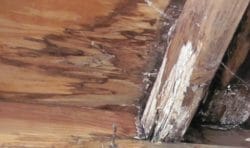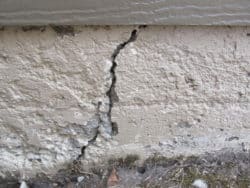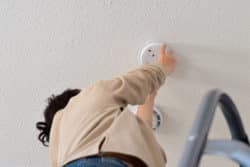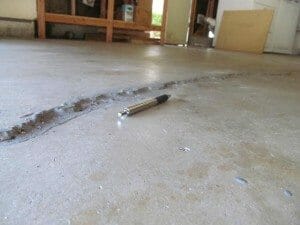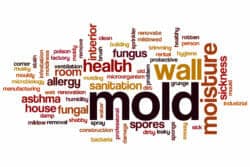Bathroom Vent Fan Codes | Venting into Attic | Mold & Structural Issues
Home » Codes & Permits »
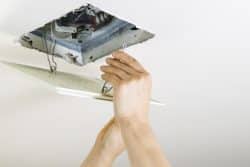
Bathroom fan vent code requirements, include no venting to attic areas to help reduce mold or structural problems
Bathroom ventilation codes require a bathroom exhaust fan to vent to the exterior, not the attic, for health and structural reasons.
Are exhaust fans required for a bathroom?
Not all building jurisdictions require bathrooms to have an exhaust fan if the bathroom has an openable window that has 1.5 square foot of open area when open. If no openable window, then a mechanical exhaust system, i.e. a bathroom exhaust fan is usually required. Note that in some states a mechanical exhaust fan may be required, even if there is an openable widow, especially if the bathroom has a shower, tub, spa or sauna.
Bathroom ventilation code requirements have one basic intent
The basic intent of bathroom ventilation codes are to remove moisture laden air from a bathroom to the exterior of the home; this is usually considered much more important from a code standpoint than removing odors.

Many experts feel that the ideal relative humidity in a home should range between 40% to 50%, depending on many factors, including the season and where the home is located in the U.S. However, bathrooms may develop humidity levels above 80%, especially when hot showers or baths are taken and when these high levels of moisture are dealt with improperly, problems develop, some of which can be serious.
Bathroom exhaust fans are often called extraction fans by contractors. These fans:
- Help reduce excessive moisture which creates negative effects on a home.
- Improves health conditions by preventing or reducing mold and mildew from developing.
- May cause structural issue if their vents discharge in the wrong locations, are installed improperly or the vents are damaged or leaking.
Building codes prohibit bathroom vent fans from terminating or exhausting into:
- attics
- crawl spaces
- soffits
- ridge vents
Note that a quick call or visit to your local building department will usually answer any questions you have about your home and the local codes regarding bathroom venting requirements.
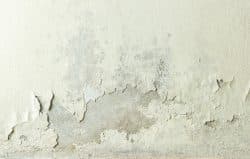
Failure to remove moisture laden air properly in a homes’ bathroom may cause:
- Paint on the walls and ceiling to peel or flake off
- Moisture stains on walls and ceilings
- Mold or mildew on walls and ceilings
- Fogging of mirrors
- Rusted fixtures
Condensation from moisture laden air can cause health and structural problems as well, especially when the bathroom vents discharge moist air into attics or crawl spaces. Leaking and damaged vents, as well as, improperly installed ones also can cause problems.
Health and structural issues when a bathroom is not vented properly
Higher level of problems and concerns
- Mold and mildew can develop in attics and crawl spaces. Generally, most homeowners do not go into their attic or crawl under their home to see if there’s evidence of mold or mildew, because of this mold may go undetected for months or even years, causing lots of damage.
- Insulation. Venting moist air into an attic or crawl space can result in damp or wet insulation; reducing the effectiveness of the insulation.
- Health issues. Children, seniors and people with weaken immune systems or respiratory issues are usually more susceptible to mold issues than others. ( Read about mold and related health issues in a home )

- Termites. Moisture laden air, damp wood and humid spaces are ideal for Dampwood, Formosan and Subterranean termites: they flourish in damp or decaying wood. Drywood termites do not need moisture nearby but get their moisture from the wood they digest.
- Dry rot and wet rot. Interestingly both dry rot and wet rot involve moisture. Moisture is required for dry rot and usually requires a moisture content of 20% or more. Basically, dry rot is a fungus, often called Serpula Lacrymans, which can cause tremendous damage to a wood framed home over time and in general is more destructive than wet rot. Dry rot is considered to be one of the most destructive types of wood decaying fungi. ( Read more about mold, funguses and dry rot )
A Quick Homeowners “9 Point Checklist”
Take a couple of minutes and run through this checklist to see if there is anything that needs correcting before a serious problem develops. Catching problems early are much less expensive to fix, than waiting till later when they are really costly to correct.
1 Is the exhaust fan working, I mean really working well? Even though you can hear the sound of the fan; is it clearing out all the moist air in the room or is there moisture building up on the mirrors, walls, or fixtures. If so, then there may be a clogged vent duct, the fans’ flapper may be stuck shut or the fan may be undersized for the room size.
2 Moisture droplets dripping from the exhaust fan or ducting. As warm moist air moves through a fans vent system in the attic the duct often become cooler, especially in the winter, thus condensate may form and drip back down through the fan itself. Condensate may also be dripping off the exterior surface of the vent duct in attic or crawl space. This dripping as a result of condensation along with moist air being exhausted into an attic area can be destructive.
3 Are there any gaps between the exhaust fan housing and the drywall? Normally the drywall will be cut out where a bathroom fan is installed. Any spaces between the fan housing and the drywall should be sealed with expandable spray foam insulation or caulking. This is a preventive maintenance issue.
4 Is the vent ducting crushed or bent restricting air flow? Vent ducting should not be kinked, bent or crushed, for it reduces the effectiveness of the fan and may cause the fan to be noisier than normal. Sharp 90’s should be avoided because they reduce the airflow. Using milder or longer 90’s is better for more air flow. Sagging ducts should be avoided, as well as, long duct runs, especially in colder climates; for there is a high risk of moisture build-up in the ducts.
5 Check the duct connections. Are all ducts fully secured together and joints sealed properly? No loose or missing duct tape. Most contractors will use foil backed duct tape, not regular old duct tape. If the existing duct tape is loose or damaged, consider up-grading the quality of duct tape. It is not uncommon to find two sections of duct totally separated, resulting in moisture laden air being dispersed in the attic, crawl space and when discovered should be re-secured and sealed.
6 Is the bathroom fan ducting insulated? Check the attic areas or where you can see the ducting that will be exposed to cold temperatures to see if well insulated. If not insulated, then insulating the existing ducting is highly recommended.
7 Is the vent piping rusted or does it have holes in it? Any vent piping or ducting with holes in it should be repaired or replaced, for the holes will allow moisture laden air to escape.
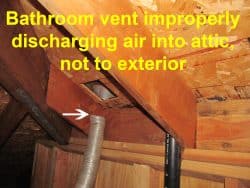
8. Vent termination point. The two most common locations for a bathroom vent to terminate is on top of the roof or through an exterior side wall. This point where the vent terminates and discharges the bathroom air should be checked for damage and to see that the air is actually exhausting properly; that it is not blocked or restricted.
Usually where you terminate the vent duct there is a louver, screen or some form of damper that helps prevent wind and rain from blowing back into the vent pipe, as well as, helping prevent insects, mice and other creatures from entering the venting. Check for damage, missing parts and that moving parts (i.e. louvers) are actually working properly.
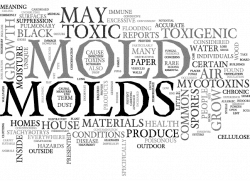
9. Mold or mildew evidence. Are there any musty type odors, moisture stains or evidence of mold and mildew?
Since mold generally requires moisture or high humidity, a homeowner can purchase an inexpensive hygrometer for $10 to $25, that can be used in measuring the humidity levels in the home and bathrooms. It can also be used for determining if the attic or crawl space has a high humidity level which is a “yellow or red flag” that there’s a problem.
Preventive measures you can do to reduce bathroom humidity and condensation
If you notice that your bathroom is steaming up, or you have a musty odor, or dark discoloration spots on the walls or ceiling in your bathroom; then you should check to see if you have a ventilation problem. Also, be proactive and review the “9 Point Checklist” to see if you may have an improperly installed vent fan or ducting.
Add a exhaust fan if there is not one in the bathroom
Bathrooms that do not have an exhaust fan will usually benefit by having one if there is a humidity problem. Bathrooms with just an openable window tend to have condensation issues, as well as mold and mildew, especially in the winter, for people don’t like opening a bathroom window in the winter.
Put in a more powerful vent fan
Should the existing fan not be doing the job, consider replacing it with a new and more powerful exhaust fan.
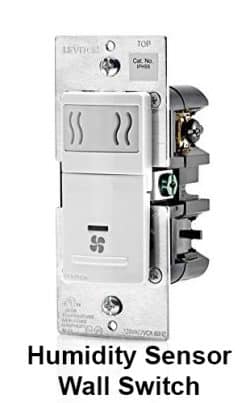
Replace the existing wall fan switch with a humidity sensor fan wall switch
These wall switches will automatically activate the fan when the humidity level in a bathroom reaches a certain point, i.e. 60% or 65% and when the humidity level goes back down to a normal range the fan automatically goes off; no guessing and it saves electricity as well.
Great for all bathrooms, but especially so where there are kids, teenagers or people who may forget when to turn the fan on or off. Plus they don’t break the bank to buy one; they’re reasonably priced when considering the problem.
Upgrade to a vent fan that has a built in humidity sensor
For some people, one solution for high humidity issues in their bathroom is to replace their existing fan with an exhaust fan that has a humidity sensory switch in it.

- The importance of having a bathroom well ventilated and where the exhaust fan and ducting is installed per code is often overlooked by many homeowners. This can result in health issues, higher maintenance cost and structural problems.
- It’s key that moisture laden air be exhausted to the exterior of a home properly and that there’s no damaged or leaking ducts, especially in the attic or crawl space.
- Moisture stains, mold, musty odors, fogging mirrors, condensate on the walls and ceiling, inoperative fans in a bathroom are “yellow or red flags” that you have a ventilation problem. These should be reviewed and corrections made as necessary. Additionally, doing a “9 Point Check” of potential problems is wise; catching problems early can help avoid costly repairs later.


